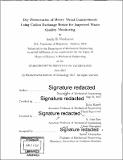Dry preservation of heavy metal contaminants using cation exchange resins for improved water quality monitoring
Author(s)
Hanhauser, Emily B
DownloadFull printable version (17.60Mb)
Other Contributors
Massachusetts Institute of Technology. Department of Mechanical Engineering.
Advisor
Rohit Karnik and A. John Hart.
Terms of use
Metadata
Show full item recordAbstract
Water quality monitoring is crucial to identifying and sustaining safe drinking water sources, tracking contamination events and remediating polluted sources. Monitoring of water sources is usually performed using a combination of field test kits and centralized laboratory analysis. While field test kits are easy and rapid to use, they are often inaccurate and cannot test for all parameters of interest. On the other hand, centralized laboratory testing can quantify parameters at trace levels using high throughput instrumentation, but preserving and transporting large volume water samples to these labs is time consuming and labor intensive. These challenges are especially problematic for rural or resource-limited settings, such that monitoring of drinking water sources in these areas is limited. Inspired by dried blood spotting, which revolutionized centralized testing for clinical trials, this thesis seeks to explore and develop a dry preservation technology for improved water quality monitoring. The technology includes a dry preservation device incorporating a sorbent, which collects and preserves contaminants from a water sample in a format that is easily transported or shippable. When the device arrives at a centralized lab, the contaminants can be removed from the device using a simple solvent elution step, yielding contaminants in a ready to test format, or the sorbent from the device can itself be directly analyzed using testing methods that accept solid samples. Such a paradigm has the potential to increase the ease and reach of water quality monitoring. This thesis describes field work, dry sampling sorbent identification and selection, kinetic parameter testing of the dry sampling sorbent, lab contaminant recovery protocol development and initial dry sampling device design for the dry storage of heavy metal cation contaminants. Heavy metals, such as lead, nickel and copper, area selected because they cause chronic health issues at very small concentrations and are increasingly found in drinking water sources due to anthropogenic contamination. The technology is developed in the context of India; however, dry sampling technology would likely find use in rural and resource limited communities around the world.
Description
Thesis: S.M., Massachusetts Institute of Technology, Department of Mechanical Engineering, 2017. Cataloged from PDF version of thesis. Includes bibliographical references (pages 141-148).
Date issued
2017Department
Massachusetts Institute of Technology. Department of Mechanical EngineeringPublisher
Massachusetts Institute of Technology
Keywords
Mechanical Engineering.